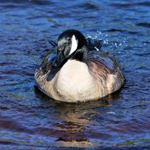Biology
- Most ducks or geese seen from March-October are not wild, but are considered domestic. Hybrids may look like wild ducks. Wild waterfowl occasionally mate with year-round resident birds and fail to migrate.
- They like to stay in groups.
- Waterfowl are generally monogamous (mate for life).
- Most of them reproduce in spring. Mallards take 24 days to hatch and 8 weeks to fledge. After hatching, mallards will generally leave the nest.
- Canada geese (monogamous) produce 4-6 eggs each year.
- Geese relieve themselves every 6-8 minutes while eating. This fact should discourage homeowners from feeding wild waterfowl.
- Most waterfowl are flightless during the summer moulting period (July-August).
- Once routines are established, they are difficult to change. Feeding wild birds creates dependence.
Problem Diagnosis
IS THERE A PROBLEM? HOMEOWNER SHOULD ACCEPT NORMAL, UNOBTRUSIVE ANIMAL BEHAVIOR
Refer to SELF-HELP if:
- Ducks are not wanted.
- Ducks are stranded at home swimming pools.
Refer to PROFESSIONAL ASSISTANCE if:
- The bird is sick or injured.
- The duck or goose is orphaned.
Self-Help
Removal of Attractants
- Discontinue feeding and encourage others to do likewise.
- Eliminate the food supply: clean up spilled grain, garbage, fallen fruit, and birdseed.
Habitat Modification & Exclusion
- Place a high fence around a small area (pools, etc.) to force the landing pattern to be very steep. Waterfowl usually cannot land this way.
- Plant tall trees around the area (pools, etc.).
- Cover the pool when it is not in use.
- Plant rose bushes to discourage nesting.
Repellents
- Scarecrows with movement in the wind (these must be repositioned frequently) are sometimes useful.
- Flags are very effective - black plastic (3 ft. x 2 ft.) sheet atop a 4 ft. pole (these must be repositioned frequently).
- Large (2 ft. diameter) helium-filled balloons attached to 50-75 lb. monofilament fishing line (moved frequently).
- Dogs in the yard.
- Objects that move in the wind or create noise like dangling aluminium pie plates (these must be repositioned frequently).
Self-Help Trapping
- Domestic and hybrid birds should not be released in wild (non-urban) waters.
- Individual, feral (domestic) waterfowl can often be approached and captured with nets and removed.
Professional Assistance
Injury is generally (but not exclusively) the only situation that falls in this category.
- Wildlife service agents: For a fee, they will remove birds from the property.
- Properly licensed rehabilitator: for sick or injured birds, contact Le Nichoir at 450-458-2809.

